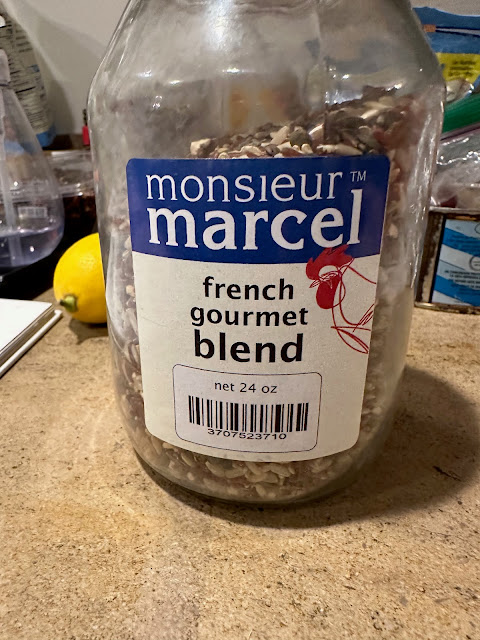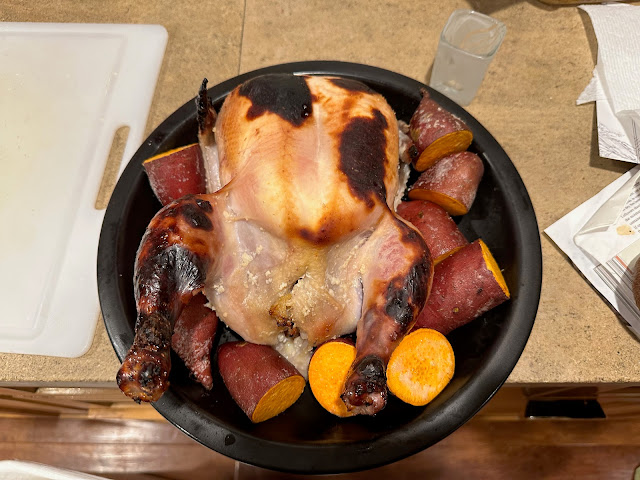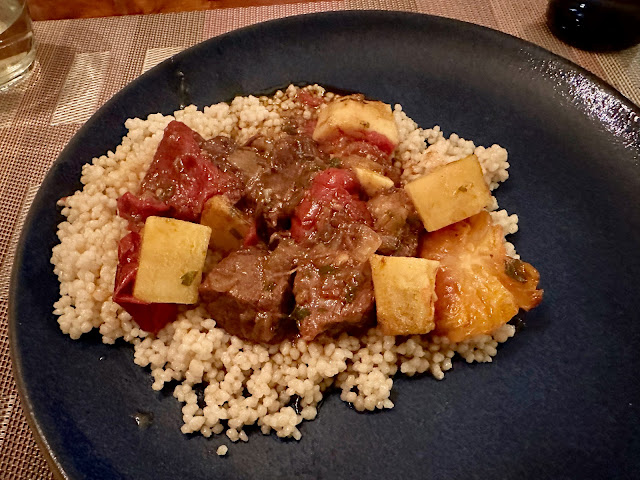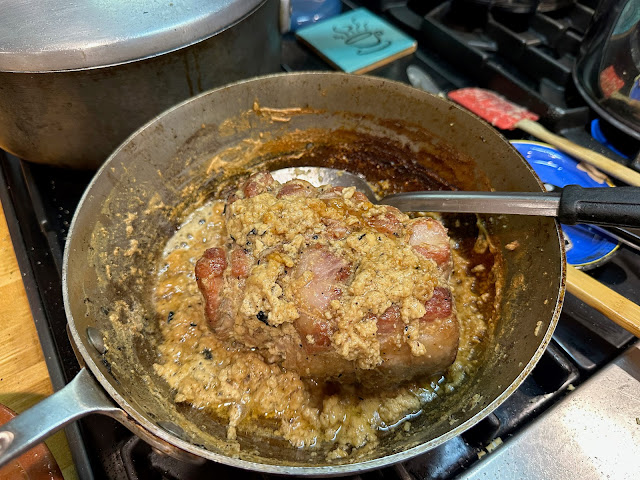We like Pork Chops. When we had our first Tomahawk Fennel Flavored Pork Chop at ChiSpacca we loved the way the seasoning worked with the Pork. Now several restaurants serve them but ChiSpacca for us remains our favorite. We made this recipe for Fennel-Rubbed Pork Chops for Two from the cookbook Dining In by Alison Roman. It was delicious. You can find the recipe on our blog of: January 12, 2021. Click the date to get the recipe. With the Pork Chops we served Rice, Lentils mix from Moncieur Marcel from the Farmer's Market.
Thursday, December 29, 2022
Fennel-Rubbed Pork Chops for Two
We like Pork Chops. When we had our first Tomahawk Fennel Flavored Pork Chop at ChiSpacca we loved the way the seasoning worked with the Pork. Now several restaurants serve them but ChiSpacca for us remains our favorite. We made this recipe for Fennel-Rubbed Pork Chops for Two from the cookbook Dining In by Alison Roman. It was delicious. You can find the recipe on our blog of: January 12, 2021. Click the date to get the recipe. With the Pork Chops we served Rice, Lentils mix from Moncieur Marcel from the Farmer's Market.
Tuesday, December 27, 2022
Roasted Shio-Koji Chicken
Thursday, December 22, 2022
Creamy Fettuccine with Pancetta and Pistachios
Pasta alla Brontese (Creamy Fettuccine with Pancetta and Pistachios)
New York Times
This easy weeknight pasta honors the town of Bronte, Sicily, renowned for its green pistachios harvested from the volcanic soil of Mount Etna. They’re famous for their flavor and bright green color. The simple pan sauce has only a few ingredients: ground pistachios, grated cheese, heavy cream, a splash of wine and pancetta. Perfect for a weeknight but interesting enough for a dinner party, this dish is as rich and comforting as fettuccine alfredo, with additional texture and depth of flavor from the crispy pancetta bits and nutty pistachio crumble.
Ingredients
Yield: 4 servings
Kosher salt
1 pound fettuccine
½ Cup Toasted, Salted Pistachios (See Tip)
½ cup freshly grated Parmigiano-Reggiano, plus more for garnish
2 tablespoons extra-virgin olive oil
4 ounces pancetta or prosciutto, cut into ¼-inch cubes
½ cup minced yellow onion
½ cup white wine
1½ cups heavy cream
Preparation
1. Bring a large pot of salted water to boil. Cook the pasta according to package instructions until al dente.
2. While the pasta cooks, make the sauce: Place the pistachios and ½ cup grated Parmigiano-Reggiano in a small food processor and pulse until mixture resembles coarse sand. (Be careful not to grind into a paste.)
3. Add the olive oil to a large, deep skillet and heat over medium. Add the diced pancetta, reduce the heat to low and allow the pancetta to render until crisp, stirring occasionally, 5 to 7 minutes. Using a slotted spoon, remove the pancetta from the skillet and reserve.
4. Add the onion to the remaining fat in the skillet and cook, stirring frequently, until translucent, about 3 minutes, being careful not to let it brown. Add the wine, increase the heat to medium and cook until it has almost evaporated, about 4 minutes.
5. Reduce heat to low and add the reserved pancetta and most of the pistachio mixture, reserving ¼ cup for garnish. Pour in the heavy cream and stir to combine.
6. Using tongs, transfer the cooked pasta to the skillet, mixing to incorporate with the sauce.
7. Transfer to a large serving platter or shallow dish and garnish with the reserved pistachio mixture, plus additional grated cheese.
Tip
If you prefer to use raw pistachios, you can toast them on a sheet pan in a 350-degree oven for 6 minutes.
Monday, December 19, 2022
Beef Tagine with Sweet Potatoes l
We made a Beef Tagine with Sweet Potatoes from The Food of Morocco. I loved this recipe. It was a combination of tastes of both Moroccan Spices and the sweetness of the Potatoes. The meat was extremely succulent. It is a great recipe. We served it over Couscous. You can get the recipe on our blog of October 2, 2009. Click the date to get the recipe.
Monday, December 12, 2022
Pork Braised in Milk
It is getting cool in Los Angeles and it was appropriate for us to cook one of our favorite pork recipes: Pork Braised in Milk. If you have never made this dish, or if you are not a cook this is the dish for you! This is a no fail, easy, delicious, surprising dish. It is fabulous and the milk become a gravy that is perfect! You can find the recipe on our blog of: October 17, 2011. Click the date to get the recipe.
Friday, December 09, 2022
Risotto of the Vigil
One of our winter traditions is to make Risotto of the Vigil every year in December. It is a very hearty Risotto. We love it! Every year I look forward to it. You can find the recipe on our blog of: December 22, 2009. Click the date to get the recipe.
Tuesday, December 06, 2022
Holiday Fruit Cake
Monday, December 05, 2022
Pot Roast
We made a beautiful tender Pot Roast. I love it served over Noodles. You can find the recipe for this fabulous dish on our blog of: March 15, 2016. Click the date to get the recipe. We started with a Little Gem Salad With Garlicky Almond Dressing. It is kind of fun to crush the Almonds to make the dressing. It is excellent! You can get the recipe on our blog of: April 10, 2022. Click the date to get the recipe.
Friday, December 02, 2022
Steak and Best Potatoes
Not much to add to a perfect Steak served with Nancy Silverton's great Potato recipe. We don't usually grill steak now but rather first char one side at high heat in a cast-iron skillet then transfer to a very hot oven. It works perfectly. You can get the Steak recipe on our blog of: Feb 17, 2018. Click the date to get the recipe. You will never make regular Baked Potatoes again if you follow her recipe. You can find the recipe on our blog of Feb 8 2022, click the date to get the recipe. We serve the Steak with Arugula and a drizzle of Balsamic Vinegar.
Thursday, December 01, 2022
Crispy Fried Rice
Tuesday, November 29, 2022
Drunken Steam-Fried Drummettes in Shochu Sauce
We made Drunken Steam-Fried Drummettes in Shochu Sauce. Perhaps we weren't drunk enough to enjoy it. We found it bland and washed out. Sometimes you win, sometimes you don't. Try and it if you like it, let us know.
Drunken Steam-Fried Drummettes in Shochu Sauce
Donabe
1½ pounds chicken drumettes
1 Teaspoon sea salt
3 green onions, halved crosswise (white and green parts,
1 tablespoon thinly sliced peeled
Fresh ginger
¼ cup shochu (Japanese distilled drink), preferably rice shochu
3 tablespoons soy sauce
2 tablespoons raw orown sugdi
1½ teaspoons kurozu (Japanese black vinegar or rice vinegar
4 to 5 green cabbage leaves
Minced chives, for garnish
Ichimi togarashi (Japanese ground
This simple dish is ideally suited to casual izakaya Japanese pub)-style get-togethers. I find that shochu tends to make the chicken more tender and also gives it a nice aroma. I use rice shochu, but other types of shochu or even sake can work with this dish, too. Just put the ingredients in a tagine-style donabe and let it do the work for you. -Naoko
Season the chicken all over with the salt and allow to marinate for 30 minutes or cover and refrigerate overnight.
Spread the green onions and ginger in the danabe. Add the chicken and spread out in a single layer. Add the shochu, haches, soy sauce, brown sugar, and vinegar over the chicken
Spread out the cabbage to covers a chicken entirely. Cover with the lid and set over medium-high heat. Cook for 51 cut down the heat to medium-low and cook for 25 to 30 minutes long or until the sauce has reduced by Half or more, stirring occasionally.
Turn off the heat and let it rest for 5 to 10 minutes.
Serve in individual bowls at the table and sprinkle with chives and
Monday, November 28, 2022
Japanese Noodle Soup with Egg and Shiitake Mushrooms
 |
| Noodle Soup with Egg and Shiitake Mushrooms |
 |
| Sesame Salmon Bowl |
We made another Asian meal: Noodle Soup with Egg and Shiitake Mushrooms, which we loved and Sesame Salmon Bowl which is also excellent. The Noodle Soup was new to us. We have made the Sesame Salmon Bowls previously. We liked both of them. You can find the recipe for the Salmon Bowl on our blog of: June 8, 2022. Click the date to get the recipe. Both of the dishes were excellent.
Noodle Soup with Egg and Shiitake Mushrooms
Japanese Home Cooking
This is a versatile noodle soup that uses fresh or dried soba, somen, or udon noodles.
To make the soup, you will prepare four components: a dashi-based seasoned broth, an egg omelet, the noodles, and the garnishes. The seasoned broth and the egg omelet can be made a day in advance. You can substitute Nitamago (Marinated Soft-Boiled Eggs), another protein (such as grilled chicken or shrimp), or vegetables for the omelet, if you prefer. The shoyu tare used to season this soup is made in a larger batch; it can be stored in the pantry for up to six months. Shoyu tare is my all-purpose sauce that I use for seasoning soups and basting grilled meats and grilled rice balls. If you have these ingredients prepped, this noodle soup will be very easy to put together.
Makes A4 Servings
8 cups Bonito and Kombu Dashi or other dashi of your choice
Scant 1 cup Shoyu Tare
1 tablespoon sake
1 recipe Dashimaki Tamago
1 tablespoon untoasted or toasted sesame oil or grapeseed oil
8 fresh shitake mushrooms, sliced ¼ inch thick or left whole if they are small
1 baby spring onion, sliced ⅛ inch thick
1 pound dried or fresh soba, somen, or udon noodles
For The Garnishes
4 scallions, white and light green parts thinly sliced crosswise about ⅛ inch thick
2 tablespoons grated ginger
1 tablespoon citrus peel (yuzu, lemon, lime) in1-inch-long julienned strips
Shichimi Togarashi
Bring the dashi to a boil in a large saucepan over medium-high heat and add the shoyu tare and sake. Reduce the heat to medium and cook for 3 to 4 minutes. Remove from heat. Taste and adjust the seasonings as needed. You can make the soup 2 to 3 days in advance and keep it in the refrigerator; reheating when you are ready to make the soup.
Cut the omelet, if using, crosswise into ½-inch-thick pieces.
In a medium skillet, heat the oil over medium-high heat. Add the mushrooms and spring onion and cook until softened, about 2 minutes. Set aside.
Bring the dashi to a boil over high heat, then lower the heat to maintain a simmer while you cook the noodles.
Bring a large pot of water to a rolling boil over high heat. Add the noodles. They will take between 2 and 10 minutes to cook, depending on the type of noodles you are using; cook them to your desired tenderness, letting your teeth be your guide. Rinse the noodles vigorously under running water to remove the surface starch, then drain. Divide the noodles into individual soup bels
Arrange the sliced omelet, mushrooms, and onions on top of the noodles in the bowls. Pour the piping hot soup into tike bowls and garnish with scallions, ginger, and citrus slivers. Serve immediately with the shichimi togarashi on the side
Friday, November 25, 2022
Thanksgiving+1
Thursday, November 24, 2022
Thanksgiving
 |
| Trio of Desserts |
 |
| Roast Pork |
 |
| Turkey from Chinese Restaurant |
 |
| Radicchio Salad from Bar Muruno |
 |
| Spanakopita |
 |
| Pork Shoulder |
Pernil
New York Times
Perhaps the best known and most coveted dish from Puerto Rico, pernil is a positively sumptuous preparation for pork shoulder. It’s marinated (ideally overnight) in garlic, citrus and herbs, then slow roasted on high heat to achieve a crisp chicharrón, or skin. Traditionally, it’s prepared for Thanksgiving or Christmas, but for those of us in the diaspora, it’s made for most special occasions. Shoulder is also a relatively inexpensive cut of meat, and it yields a lot of servings, leading to exciting leftovers. This recipe is deeply indebted to the chef Maricel Presilla and her recipe in “Gran Cocina Latina,” her cookbook published in 2012. Her method is a foolproof way to get that chicharrón as well as tender meat that falls off the bone. It’s blessed by her brilliance.
Ingredients
Yield: 8 to 10 servings
For The Adobo (See Tip)
8 to 9 large garlic cloves, finely minced
3 tablespoons olive oil
5 teaspoons fresh sour orange juice (or equal parts lime and orange juice)
4 teaspoons dried oregano
8 to 9 teaspoons kosher salt
1 teaspoon black pepper
For The Pork Shoulder
1 (8- to 9-pound) bone-in, skin-on pork shoulder, preferably with skin covering the entire top layer
1 teaspoon kosher salt
Preparation
1. Prepare the adobo by combining all the ingredients and grinding in a large pilón or mortar and pestle, or simply mixing well in a small bowl.
2. Prepare the pork: Rinse and dry meat well with a clean towel. Place pork skin-side down on a large, rimmed sheet pan and poke deep, 1-inch holes throughout the meat and in the fatty layer with a paring knife, being careful not to pierce the skin. You can’t have too many holes.
3. Pour over adobo in batches, using your fingers to push adobo deep into the meat. If you’re worried about your hands smelling like garlic — which they will! — wear gloves.
4. Set out a long sheet of plastic wrap, layering with subsequent sheets as needed to ensure you can securely wrap the entire pork shoulder. Transfer pork to plastic wrap and wrap tightly, adding sheets of plastic as needed to ensure pork is completely airtight and juices are contained. Let marinate in the fridge overnight if possible, or at least least 2 to 3 hours. Set on a rimmed baking sheet or disposable aluminum foil pan in case it leaks.
5. Once the pork has marinated, heat oven to 400 degrees. Working over the sink, carefully remove pork from plastic wrap, discarding any remaining adobo. Place the marinated pork shoulder skin-side up in a deep roasting pan, and wipe the skin with a clean cloth. Rub skin with 1 teaspoon salt.
6. Loosely tent foil over the pork shoulder, spraying the foil with cooking spray or brushing with oil in any areas that may touch the skin, as it will stick. Transfer to the center of the oven.
7. Roast in the oven for 1 hour, then carefully remove the foil and rotate the pan. Continue roasting for another 2 to 3 hours, rotating every hour or so, and watching closely. Add water to the pan as needed when juices evaporate. The meat is done cooking when the juices run clear and the thickest part of the shoulder registers 160 degrees with a meat thermometer. The skin may take more time to crisp but watch closely so that it does not burn. Tap the top of the skin with the back of a knife or metal spatula and listen for a decidedly hollow sound.
8. Remove from the oven and let rest for 10 to 15 minutes, then transfer to a large cutting board. (For cleaning instructions for the pan, see Notes.) If desired, remove the skin from the roast by slicing it along the underside of the bone with a long, sharp, slender knife. Run the knife underneath the skin starting from the bottom until loosened, then lift the skin from the meat. Use kitchen shears to cut into serving pieces and let them rest in the warm oven until ready to eat. Trim excess fat from the meat if desired, and slice as desired, in large chunks or slices, to serve.
Tips
You can use a smaller or larger pork shoulder but calculate your adobo accordingly by using the following formula per pound of meat: 1 large garlic clove, 1 teaspoon olive oil, 1 teaspoon kosher salt, ½ teaspoon sour orange juice, ½ teaspoon dried oregano and ⅛ teaspoon black pepper. If using a smaller pork shoulder, you may want to reduce the amount of salt slightly.
Use a pan that can handle char. You can line your pan with foil, but that can be even messier. When you’re ready to clean, combine ½ cup baking soda and enough hot water to cover the burned spots, and let rest for half an hour. Char should release easily with your abrasive tool of choice.
Monday, November 21, 2022
Roasted Shio-Koji Chicken
We really liked Roasted Shio-Koji Chicken. We have been cooking and eating a lot of Japanese and Korean dishes. I think I am a sucker always for Crispy Skin. The preparation of the Mushrooms is time consuming and we aren't sure it is necessary. This dish has very tasty and crispy skin. It is a keeper. We will make it again. This is requires a Donabe to cook the chicken in.
Roasted Shio-Koji Chicken
Donabe
1 about 4-pound whole chicken
½ cup Shio-Koji, ground to a smooth paste 2 pounds button mushrooms, trimmed (we bought this on-line)
2 dried shiitake mushrooms
Sea salt
1 3 by 6-inch piece kombu
2 small (6 to 8 ounces each) satsuma-imo (Japanese sweet potatoes), or 1 large one, halved, skin brushed to remove any dirt
2 tablespoons chicken fat or butter, 8 ounces maitake (hen-of-the-woods) mushrooms, trimmed and whole clusters halved, or substitute with large shiitake mushrooms
12 ounces gai lan (Chinese broccoli), stems peeled
3 to 4 green onions, sliced thinly on the diagonal, for garnish
Shichimi togarashi (Japanese seven-spice blend), for serving
This recipe makes use of two techniques that give a simple roast chicken a flavor that cannot be obtained in any other way. The recipe begins with Shio-Koji, the fermented mixture of salt and koji (malted rice) that gives sake, soy sauce, and miso their unique flavors. The chicken is cooked in a tagine-style donabe, its radiant heat browning the skin and leaving the interior tender. The shio-koji makes the chicken slightly sweet and intensely flavorful.
Note, plan this recipe ahead, it requires one day of marinating and ten hours to bake. -Nick Balla and Cortney Burns
To marinate the chicken, rub the chicken with the shio-koji and refrigerate for 24 hours. Remove from the refrigerator and wipe off the koji paste. Allow the chicken to come to room temperature for at least 1 hour before continuing.
Preheat the oven to 180°F.
Grind the button mushrooms in a food processor until they are thoroughly minced. Place the dried shiitake mushrooms on the bottom of a baking pan and cover with the minced button mushrooms and a pinch of sea salt. Cover the pan with a tight-fitting lid and place in the oven for 10 hours. Add the kombu and return to the oven for 1 hour.
Remove the mixture from the oven and strain through a fine-mesh sieve.
Taste the mushroom broth for seasoning. If using the broth immediately. reserve at room temperature. This broth can also be made ahead and stored in a refrigerator for up to 3 days.
Heat the oven to 450°F
To assemble the dish, rub each of the satsuma-imo with 1 tablespoon of the chicken fat and a pinch of sea salt. Place the skillet of the donabe in the oven for 10 minutes; remove from the oven and test that it is hot enough by flicking a drop of water on the surface. If the water sizzles on contact, it is ready to roast the chicken. Place the chicken in the center of the skillet with the breast side facing up. Place a satsuma-imo on either side of the chicken. Return the skillet to the oven with the lid next to it to heat it. Cook the chicken and satsuma-imo for 20 minutes, or until they just start to brown. Place the lid over, the skillet and return to the oven for 25 minutes.
Remove the donabe from the oven to check that the chicken and satsuma-imo have finished cooking. The chicken should be about 155°F and the satsuma-imo should be tender when a skewer is inserted. Return to the oven and cook longer if needed. Transfer the chicken and satsuma-imo in a shallow baking dish and cover with a lid to keep them warm while finishing the dish. Place the skillet over low heat on top of the stove. Place the maitake mushrooms cut-side down and the peeled gai lan in the bottom of the vessel and pour the mushroom broth over the top. Simmer for 5 minutes, until the top, mushrooms and gai lan are tender.
While the vegetables are simmering, carve the chicken and slice the satsuma-imo. Arrange the chicken and satsuma-imo over the broth with the mushrooms and gai lan. Garnish with the green onions and serve immediately. Place the shichimi togarashi on the side for guests to use on the chicken as desired.






















.jpeg)
.jpeg)
.jpeg)


















